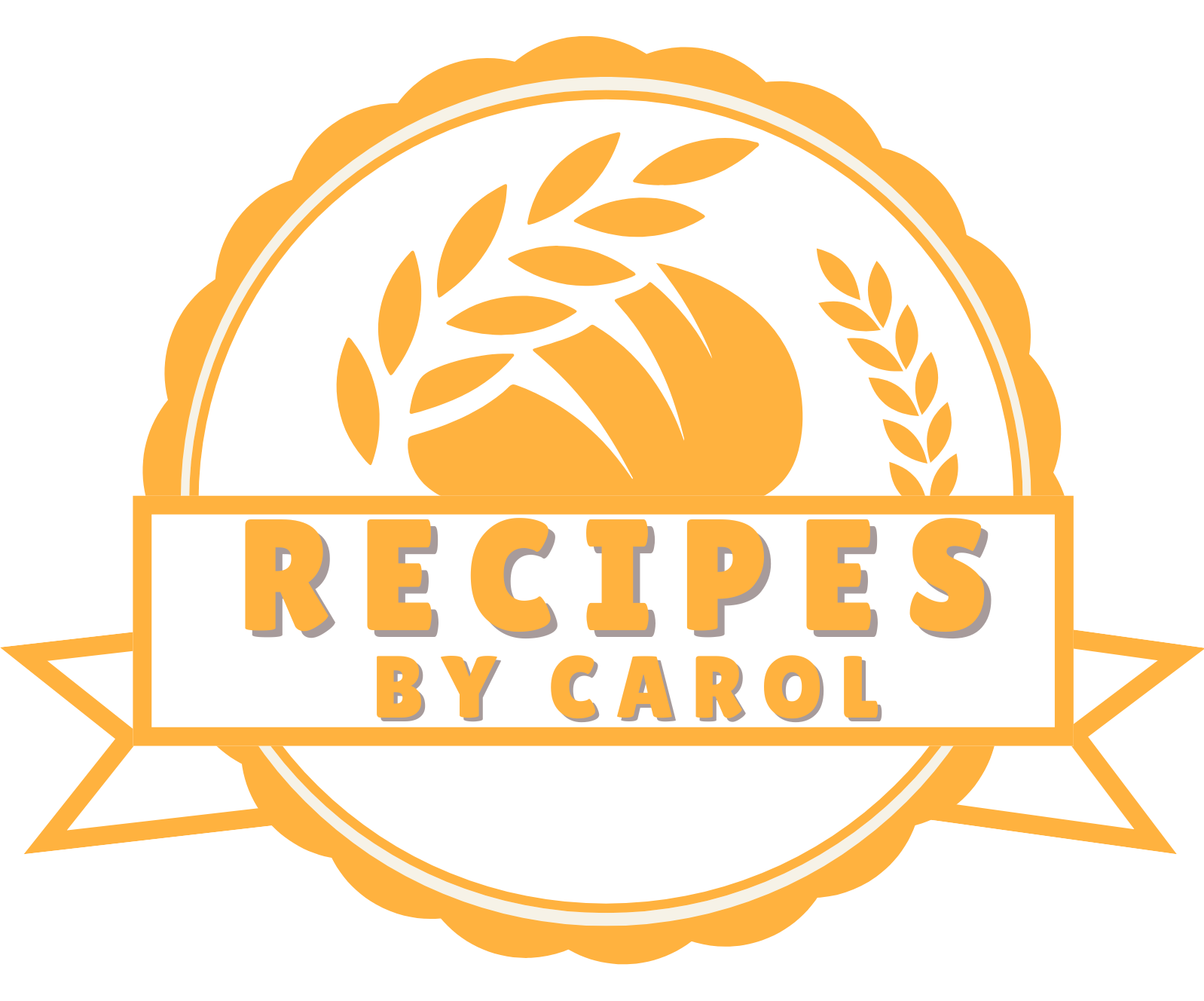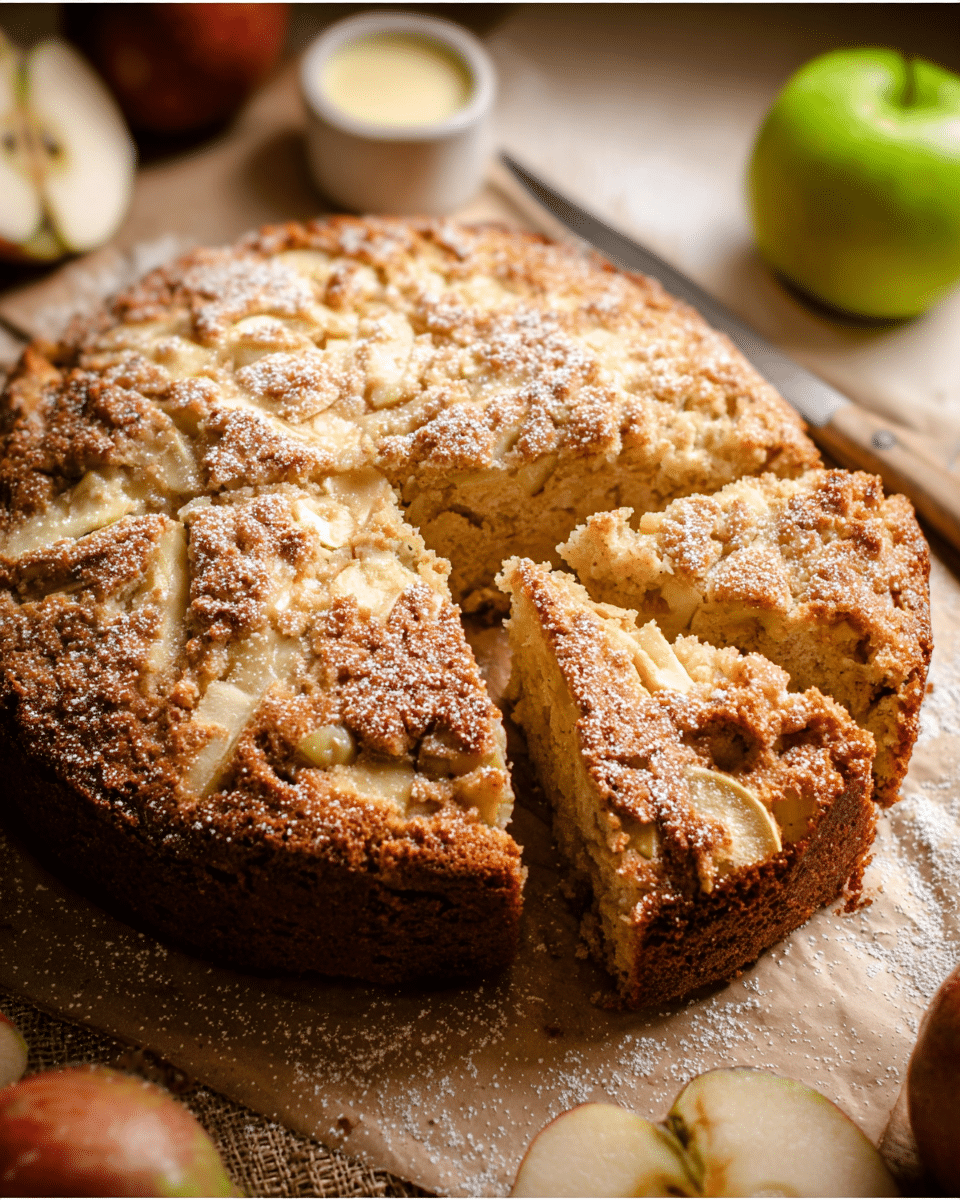The Irish Apple Cake, or Kerry Cake, is a rustic, subtly spiced dessert deeply rooted in Irish tradition. With tender chunks of tart Granny Smith apples tucked into a soft, bread like crumb and topped with a gentle crust of sugar, it offers a warm taste of heritage. What elevates this humble dessert into pure indulgence is the accompanying custard sauce a light, pourable cream that complements the subtle spices with rich vanilla notes.
Perfect for St. Patrick’s Day or any cozy evening, this cake captures the simplicity and heart of rural Irish kitchens. Whether served warm or cold, it invites you to slow down and savor every comforting bite. With pantry-staple ingredients and approachable steps, it’s a lovely bake that feels both nostalgic and new.
Full Recipe:
Ingredients:
For the Cake:
-
3 cups cake flour
-
2 tsp baking powder
-
1/8 tsp salt
-
1/2 tsp cinnamon
-
1/2 tsp nutmeg
-
1/2 tsp ground cloves
-
12 tbsp salted butter (cold or room temp)
-
1 cup sugar
-
2 large eggs
-
3 large Granny Smith apples (peeled and diced)
-
1 cup whole milk
-
2 tbsp additional sugar for topping
For the Custard Sauce:
-
6 large egg yolks
-
1/4 cup sugar
-
1 1/2 cups whole milk
-
1 tbsp vanilla extract
Directions:
-
Preheat oven to 375°F (190°C).
-
Grease an 8 or 9-inch springform cake pan and line the bottom with parchment paper.
-
In a large mixing bowl, sift together cake flour, baking powder, salt, cinnamon, nutmeg, and cloves.
-
Cut butter into the flour mixture using a pastry cutter or your hands until it resembles coarse crumbs.
-
Stir in 1 cup of sugar.
-
Add diced apples and toss to coat.
-
Whisk together eggs and milk, then gently fold into the dry mixture. The batter will be thick.
-
Spoon batter into the prepared pan, spreading evenly.
-
Sprinkle the remaining 2 tablespoons of sugar on top.
-
Bake for 45–50 minutes or until a toothpick inserted comes out clean.
-
Cool in the pan for 10 minutes, then transfer to a wire rack.
Custard Sauce Instructions:
-
In a bowl, whisk together egg yolks and 1/4 cup sugar until smooth.
-
In a saucepan, heat milk over medium-low heat until steam rises (do not boil).
-
Slowly whisk hot milk into the egg mixture, a little at a time, to temper the eggs.
-
Return the custard mixture to the saucepan and cook over low heat, stirring constantly, until it lightly coats the back of a spoon (about 5–10 minutes).
-
Remove from heat and stir in vanilla. Serve warm or chilled over the cake.
Prep Time: 10 minutes | Cooking Time: 50 minutes | Total Time: 1 hour
Kcal: ~340 kcal per slice | Servings: 10–12 slices
The Heart and History of Irish Apple Cake (Kerry Cake)
Irish Apple Cake, often known by its regional name “Kerry Cake,” is one of those timeless desserts that brings with it a taste of tradition, a whisper of the past, and a warm sense of home. Although not as globally recognized as soda bread or shepherd’s pie, this humble cake carries immense cultural value and is steeped in Irish history. Lightly sweet, rich in fruit, and often served with a delicate custard sauce or cream, Irish Apple Cake is a rustic dish that’s as perfect for a chilly autumn evening as it is for a festive St. Patrick’s Day table.
In today’s modern kitchens, this cake offers something almost nostalgic a reminder of simpler times and traditional, unfussy baking. It’s made with common pantry staples, emphasizing substance over sweetness, and is frequently praised for its moist crumb and aromatic spice profile. More than just a dessert, it’s a legacy dish one that speaks to Ireland’s agricultural roots and resourceful culinary practices.
A Taste of Irish Heritage
To understand the charm of Irish Apple Cake, one must consider its origins. Ireland’s long-standing relationship with apples dates back to ancient Celtic traditions, and apples were often used in seasonal feasts and folklore. The Irish countryside is dotted with apple orchards, particularly in counties like Armagh, which is known as the “Orchard of Ireland.”
The cake itself was traditionally baked during apple harvest season, when surplus apples would be used to make rustic bakes and preserves. Unlike many modern desserts, Irish Apple Cake is not excessively sweet a reflection of a time when sugar was expensive and sparingly used in Irish households. This makes the cake feel wholesome and deeply connected to the land and the seasons.
Kerry Cake, in particular, reflects the cooking style of the southwestern county of Kerry, where practical and hearty dishes were the norm. Baked in cast iron pans over an open hearth, early versions of this cake had more in common with sweetened breads than what we think of as cakes today.
More Bread Than Cake: The Texture Debate
One of the most fascinating elements of Irish Apple Cake is the way it straddles the line between a quick bread and a true cake. While today we associate “cake” with something spongy, light, and sugar-laden, this dessert leans into denser textures. It’s soft, yes, but not airy. The batter is thick, almost dough-like, and folds around chunks of tart apples that soften during baking but retain their shape, adding a contrast in texture.
In some traditional preparations, the apples are layered throughout; in others, they’re mixed directly into the batter. Modern takes often dice the apples into bite sized pieces, which ensures even distribution and prevents sogginess. The resulting bake is hearty, moist, and infused with the warm, comforting aroma of spices like cinnamon, nutmeg, and cloves.
Granny Smiths and the Bramley Dilemma
One of the only ingredients in Irish Apple Cake that has historically varied by geography is the apple itself. In Ireland, Bramley apples are the gold standard a variety that’s tart, firm, and holds its shape beautifully when baked. However, these apples are not widely available in North America, so Granny Smith apples have become the common substitute.
Granny Smiths offer a similar tartness and firm texture, which helps balance the mild sweetness of the cake and provides that satisfying bite in each forkful. Their resilience in heat also makes them a perfect fit for baking, ensuring they don’t dissolve into mush but rather complement the sturdy, spiced crumb of the cake.
Spices and Simplicity: The Irish Flavor Profile
One of the most unique aspects of this cake is its subtlety. Irish cuisine is known for its minimalism and natural flavors, and this cake is no exception. Spices are used delicately, not overpoweringly. Cloves and nutmeg are traditionally included, lending warmth and depth, while cinnamon more common in American baking is sometimes added in smaller amounts to round out the flavor.
Vanilla, surprisingly, is not a traditional addition, although it can be used for those who prefer a slightly richer custard or cake aroma. Instead, the primary flavors come from the apples and the butter a wholesome, dairy-rich component that defines much of Irish baking.
The top of the cake is usually sprinkled with sugar before baking, creating a subtle crust that adds texture without veering into overly sweet territory. This final touch helps to create a slightly crunchy top that pairs beautifully with the soft interior.
The Optional (but Highly Recommended) Custard Sauce
Though the cake itself is mild and comforting, many bakers elevate it by pairing it with a warm vanilla custard sauce. This sauce thin, pourable, and subtly sweet adds a rich, creamy contrast to the dense cake, enhancing its flavors without overpowering them.
Custard sauce is made from just a few ingredients eggs, milk, sugar, and sometimes vanilla but it requires gentle, careful cooking to avoid curdling or scrambling. When done right, it’s like pouring silk over the cake. For those with a sweet tooth or who are used to richer desserts, this sauce transforms the experience into something more indulgent while staying true to the cake’s rustic roots.
Alternatively, clotted cream, whipped cream, or even a scoop of vanilla ice cream work wonderfully as accompaniments.
Celebration, Seasonality, and Serving
Irish Apple Cake is often baked in honor of St. Patrick’s Day, when families look for traditional Irish recipes that celebrate heritage. However, it’s not just a once a year treat. It’s also the perfect dessert to enjoy throughout the fall and winter, especially during apple season when fresh, tart apples are abundant.
This is a cake best served warm or at room temperature, often with a hot cup of Irish breakfast tea, black coffee, or a mug of warm cider. It also makes for a beautiful offering at holiday gatherings, brunches, or cozy family dinners.
The cake keeps well, too. It can be stored on the counter for a couple of days or refrigerated for longer freshness. In fact, many fans say it tastes even better the next day as the flavors continue to deepen.
Modern Variations and Dietary Swaps
For those with dietary restrictions or different preferences, Irish Apple Cake is surprisingly adaptable. You can make it:
-
Gluten-free using 1-to-1 gluten-free flour blends
-
Dairy-free by substituting butter with plant-based alternatives and using oat or almond milk
-
Egg-free with flaxseed or chia egg replacements
Some modern versions even include walnuts, raisins, or a crumble topping, although purists often prefer to keep it simple and classic.
Conclusion:
Irish Apple Cake may not be the flashiest dessert on the table, but it’s often the one that disappears first. Its appeal lies in its authenticity the way it honors tradition without requiring fancy equipment or hard-to-find ingredients. It’s a celebration of harvest, heritage, and home baking.
For those looking to reconnect with old-world recipes or introduce new family traditions, this cake is a beautiful place to start. Whether you’re Irish by blood, marriage, or spirit, baking this cake brings a slice of that warm, countryside charm right into your kitchen. Pour yourself a cup of tea, cut a thick slice, add a ladle of custard, and enjoy a bite of Irish comfort rustic, rich, and just sweet enough.






